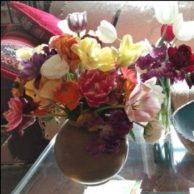 In our culture today, Valentine’s Day immediately brings to mind Romantic Love, Flowers, Gift-giving and Chocolate. And though this very old Saint’s Day has now been commercialized to the Nth degree, it’s still one of the happier occasions we celebrate, so why not enjoy it in our own way? Romance, Love, flowers, gifts and chocolate are all very positive and uplifting. And we have some recommendations for all of those categories except Romance (you’re on your own there!).[Read More]
In our culture today, Valentine’s Day immediately brings to mind Romantic Love, Flowers, Gift-giving and Chocolate. And though this very old Saint’s Day has now been commercialized to the Nth degree, it’s still one of the happier occasions we celebrate, so why not enjoy it in our own way? Romance, Love, flowers, gifts and chocolate are all very positive and uplifting. And we have some recommendations for all of those categories except Romance (you’re on your own there!).[Read More]
Blog
Late Fall Musings
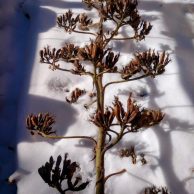
Agave seed stalk
The day before Thanksgiving in the Reshetnik-Brawer home was largely spent cleaning the house, but we also decided it was time to cut down the towering inflorescence of our Century Plant (Agave utahensis x parryi v. couesii). I held the 3”- thick stalk while Mikl cut through it with his folding hand-saw (a great tool!), then we laid it down on a ground-cloth to catch the copious seeds that fell out of the hundreds of pods. To me it felt as if we had just felled a large and noble animal or tree, and there were several quiet minutes of awe and reverence. Now that it was horizontal, we were able to get an accurate measurement of the bloom stalk’s height, 14.5 feet, and I counted 34 branches! We will be planting the hundreds (or thousands?) of seeds to produce new plants for you.
Our 32nd Gardening Season Begins March 1st!

As I write, the ground and rooftops are blanketed in snow, and the sun is streaming in the windows. Gotta love the Colorado winter! In less than a month, we’ll be open for our 32nd year as a nursery and garden center, and we are quite excited!
I don’t think we’ve ever had an easy year, but ‘easy’ isn’t an option in this business. So many aspects of running a nursery have never been predictable, and we’re always relating with thousands of details and challenges.
BUT we have a great crew and there are many things you can always count on finding when you visit Harlequin’s Gardens, and we hope you will appreciate the value you receive when you shop at our big little nursery.
For 31 years, we have always been committed to non-aggression, health and environmental stewardship in horticulture and all other spheres of Life. And this commitment will always continue!
We’ll never use toxic pesticides, fungicides, herbicides, or chemical fertilizers.
We are the best source for Colorado and regional Native Plants on the Front Range.
We have and will always specialize in Water-Thrifty plants, Native and Colorado-adapted plants and Pollinator-Supporting plants.
We are always broadening our plant offerings, often bringing into cultivation wonderful local wild plants that were previously unavailable in commerce. (*see below for examples)
Our staff, e-newsletters, classes, and hand-outs offer empowering, cutting-edge organic and environmental gardening advice and education gained from our 31 years of research and experience.
Our customer service team is exceptionally knowledgeable, helpful and accessible.
We grow most of our own plants and supplement with plants from other local and regional growers that never use neonicotinoids.
We grow our plants in our own carefully formulated potting soils that grow healthier, stronger, more resilient plants that will establish successfully into your garden.
Our pest management products are always non-toxic, child-safe and pollinator safe.
We compost and make our own powerful Compost Tea.
We aim to be a zero-waste business: we bag compost and mulches in returnable plastic bags that we reuse to reduce plastic in the environment. We also reuse nursery pots, and sell our compost tea in returnable/reusable jugs.
We offer superior, CO-specific resources and advice for supporting bees, butterflies, birds and other pollinators and beneficial insects.
We test and evaluate our soil products (composts, organic fertilizers, mulches and other amendments), and most of them are sourced locally.
We recycle and use recycled materials for our building projects.
Our greenhouses don’t use fossil fuels; our heat and energy come mostly from the Sun, with a little electricity from renewables. And this year we are installing a heat-pump system for our store!
We are located in unincorporated Boulder County, where sales taxes are only about half the rate of those in Front Range cities.
We support local growers, artists, artisans and musicians as well as non-profit environmental efforts.
We connect our customers with events and other educational and activist opportunities related to environmental, agricultural and horticultural issues.
———————————————————————————————————————————
Wild Plants we are Propagating in 2024. We have our fingers crossed that good germination and growth on the unique native plants described below will allow us to bring them to you this season.
The plants we offer will contribute to a beautiful, thriving garden that will be a joy to behold, but they can also provide so much more than a pretty picture to look at. The ecosystem services that our plants provide add much more value to your gardens.

Celtis reticulata, courtesy Oregon State University
Celtis reticulata, Netleaf Hackberry
You may be familiar with the larger Celtis occidentalis or Western Hackberry, which makes an excellent long-lived, water-wise deciduous shade tree. Netleaf Hackberry is substantially smaller, fairly slow-growing to 15’ to 25’ with a spreading canopy, interesting sculpted bark, an attractive twisting branch pattern, rough green leaves and reddish brown or purple berries. The leaves support the caterpillars of Mourning Cloak and Hackberry Emperor butterflies and a number of moths, which in turn, along with the sweet berries, attract and feed many birds. In Colorado, Netleaf Hackberry occurs in the wild in the Front Range foothills and on the western edge of the plains. It is rarely available in nurseries. We’ve seen some handsome specimens growing around Lyons. Cold hardy and highly adaptable to many soils, moisture levels and exposures, it can be grown as a small to medium-sized tree that will not require any supplemental watering after initial establishment.
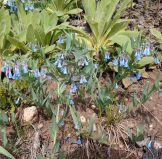
Mertensia lanceolata
Mertensia lanceolata, Prairie Bluebell, Languid Lady
Dropping way down in scale, we are hoping for good germination on this lovely local spring wildflower that inhabits a wide range of Rocky Mountain habitats and elevations, from the plains to alpine habitats, in dry partial shade under deciduous shrubs and trees, on north-facing slopes, near rock outcroppings and in sunny meadows. In mid to late spring (May and June in Boulder) the delicate bell-shaped flowers nod from slender stems, opening from plum-colored buds and maturing to blue. The leaves are blue-green due to a waxy coating, with a prominent center vein. Prairie Bluebells are in the Borage family, prized for its many striking blue-flowered constituents. The plants can produce sizeable colonies, several feet across and can range from 6 ” to 14” tall. Prairie Bluebell goes dormant by early summer, dying back to its substantial roots.
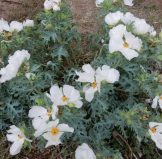
Argemone hispida, courtesy Mik Kintgen
Argemone hispida, Rough Prickly Poppy
This is one of my favorite local wildflowers. It took me awhile to notice that it was different from the Prickly Poppies I had met before (Argemone polyanthemos), being more stout and shrubby, with grey-green foliage and much more dense, numerous and slender golden prickles on all parts, from stem to bud to seed-pod. The fabulous silky white flowers are just as big (4” wide) and just as stunning as the more commonly found Argemones, but the plant is more compact, up to perhaps 15” tall where I’ve seen it growing. They both grow in the same habitat, so Rough Prickly Poppy is also happy growing dry and hot, and blooms at the same time – May to August. Found in Colorado, New Mexico, Kansas, South Dakota and Wyoming.
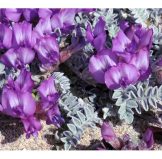
Astragalus utahensis, courtesy James L. Reveal and the LadyBird Johnson Wildflower Center
Astragalus utahensis, Utah Milkvetch
Utah milkvetch is in the legume family (Fabaceae). One finds quite a few plants in this family in the arid west. They are probably making life better for themselves and the plants around them by fixing nitrogen from the air and transferring it to their roots and the soil. Native to Utah and several adjacent states, this very pretty spring-blooming milkvetch is particularly abundant in the Wasatch Mountains. Its typical habitats include rocky hillsides, sagebrush openings, and pinyon-juniper areas. A rock garden, crevice garden, or the front of a Xeriscape garden with excellent drainage will suit it well. The plant is lovely even after bloom, with its wavy silvery pinnate leaves.
Yours in support of abundant Life,
Eve Reshetnik Brawner & Mikl Brawner
Bulbs for every Front Range Garden!
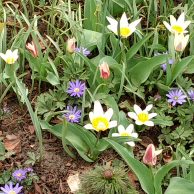
We still have LOTS of gorgeous spring-flowering bulbs! When these ‘buried treasures’ emerge, they are among the first signs of spring and are welcomed not only for their beauty, but also for providing early pollen and nectar sources for our pollinating insect as they, too, emerge.
Customers have been inquiring about which bulbs can thrive in the particular circumstances of their gardens. Whether you have a rock garden, native garden, xeriscape, fragrance garden, traditional flower border, cutting garden, or meadow, or you are living with deer, squirrels, chipmunks, limited water, baking sun, shade, clay soil or decomposed granite, there are spring flowering bulbs you can grow successfully, and we still have plenty of them! We carefully curate our selection to provide the best of the best for our climate and all our various garden types.
You Never Know, with Nature!
 Well, that was a false alarm!
Well, that was a false alarm!
You heard it from us (and all the weather guessers in the media) – we were going to have our first freeze, possibly a hard freeze, late last week. As my friend Elise put it, after harvesting all of her dahlia blooms, tomatoes, etc., “Huh?”.
In fact, Mikl and I did clear counter space and we did spend all day Thursday harvesting, cutting down and cleaning up much of our vegetable garden, and starting up the dehydrator to dry what seemed like thousands of tomatoes. And we hauled in all the houseplants that spent the summer outside. Our winter squash harvest was remarkable, especially considering that the bed where they were planted had been neglected most of the season, with only 3 or 4 intentional waterings.[Read More]
Protecting your Plants, Pampering Yourself!

It’s time to clear counter space in your kitchen and bring in final harvests of tomatoes, peppers, basil, ground cherry, beans, and squash for whatever processing you like to do. My dehydrator has been churning out dried tomatoes to snack on and use in soups, sauces and stews through the winter. Frost is predicted for Friday and Saturday nights (29-30 deg. F) and can be damaging or fatal to these summer crops. On the other hand, if you’re not ready to say goodbye to them this week, we have the knowledge and tools you’ll need to protect your plants! (see this article for more)
Our annual, month-long Holiday Gift Market, open through October 29th, is the perfect place to warm up and enjoy perusing the work of many local artists and artisans. Some of our offerings are available this month exclusively at Harlequin’s Gardens, and nowhere else! From art for the home to personal adornment, the best books for adults and kids, from gardening gifts to delicious treats for foodies, you’ll find unique and beautiful items.[Read More]
Our 12th Annual Holiday Market is Open!

If you’ve been to Harlequin’s Gardens, you know that what Mikl and I and our wonderful staff have collaborated on these past 31 years is much more than a place to purchase plants. We believe “our primary product is knowledge”, and much of our work has been to develop and support deeply knowledgeable gardeners who value sustainability. We grow many of our own plants, but truly, thanks to you, we’ve also grown a community.
Our annual, month-long Holiday Gift Market, open through October 29th, is our yearly gift to you. For the past 12 years we have been making space for a community of artists and performers to share their talents, and it’s our great pleasure to introduce the gardening community to these members of Boulder County and Colorado’s artistic community. Please be our guests this month and come take a look at the abundance of beauty available – both from the natural world and crafted by human hands.
2024 Bulbs Are In!
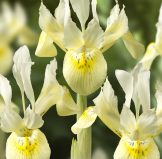 We go the extra mile to bring you special bulbs that other nurseries just don’t offer. Many of them are delightful smaller beauties at home in the front of the border, under deciduous trees and shrubs, and in the rockery. They are selling quickly, so be sure to come in to be sure of the best selection. Here is a list, and descriptions, of the fall and spring-blooming treasures for your home garden!
We go the extra mile to bring you special bulbs that other nurseries just don’t offer. Many of them are delightful smaller beauties at home in the front of the border, under deciduous trees and shrubs, and in the rockery. They are selling quickly, so be sure to come in to be sure of the best selection. Here is a list, and descriptions, of the fall and spring-blooming treasures for your home garden!
Our 2025 Holiday Market Opens Nov. 20th!

This week our staff is busy, busy, busy transforming our store into our 13th Annual Holiday Gift Market! We work hard to create a beautiful and interesting display of our local artisanal products so that you can shop for your holiday gifts in a relaxed and homey atmosphere.
Be sure to browse our 2025 HOLIDAY GIFT MARKET CATALOG, we will be adding several new artisans and products all throughout the sale!During the Holiday Gift Market you’ll be able to shop our Flowering Bulbs for indoor forcing just in time for the Holidays – and to find houseplants, soil products, and more! Just as in our plants and nursery products, our standards are high. We offer goods from dozens of artisans that are Local, Sustainable, Pure, Non-toxic, High-quality, Beautiful, Unusual, Innovative, Practical, Delightful, and Durable.
VIEW OUR 2025 HOLIDAY GIFT MARKET CATALOG!
We are so appreciative of your support and invite you and your family and friends to visit our Holiday Gift Market again this year!
—————————————————————————————————————————————————————————————
Be sure to include a visit to our Holiday Open House Saturday or Sunday November 22nd and 23rd for live music from stellar local musicians playing fascinating instruments and music not commonly heard! Bring your family and enjoy our beautiful free music, and delicious treats while you shop!
HOLIDAY OPEN HOUSE
SATURDAY and SUNDAY, Nov. 22 & 23
Featuring Treats and Live Music!
Saturday, 11-22
10:30 to noon: Paul Vissvader on guitar – Hawaiian and beyond
12:30 to 2:00: Renowned harpist Margot Krimmel. Celtic and original harp and vocals.
Harp player Margot Krimmel brings creative musicianship to her work as a performer, teacher, composer, and freelancer in the Boulder and Denver area. As a solo performer, Krimmel has won diverse awards ranging from first place in jazz (Pop and Jazzfest; Tucson, AZ), first place in traditional music (Scottish Highland Festival; Estes Park), and third place in composition for Celtic harp (Rencontres Harpe Celtique, Dinan, France). Two of her compositions placed in the International New Century Harp Music competition 2007.
Sunday, 11-23
10:30 to noon: Nicolette Andres – Norwegian Hardanger fiddle and Celtic Fiddle
Fiddler Nicolette Andres is a local of Colorado. The Hardingfele or Hardanger fiddle is Nicolette’s main instrument. Although unfamiliar in ways, its transcendental, melodic, expansive qualities evoke imagery and emotion that cannot be put into words. Nicolette has been studying the oral tradition of the Hardingfele since 2020, and also writes her own music.
12:30 to 2:00: Tea at Six – harpist Cora Wiess – Moore & Dylan Butler on guitar & banjo – Celtic & more
Cora Wiese Moore began playing the folk harp at age 10 and pedal harp at age 15. In 2020 she was introduced to the Irish session scene and transitioned to learning music mostly by ear. She plays with traditional expectations of the harp and supports the ongoing metamorphosis of the contemporary Irish and Scottish tradition.
Our 2023 Holiday Market Opens Sept. 30th!

From your previous visits in the last eleven years, many of you know that our Holiday Gift Market is the most rewarding, enjoyable place to shop for your holiday gifts, relaxed and far from the madding crowd! When the Covid pandemic began, we realized that the only way we could keep our customers (and staff) safe and happy while shopping our Holiday Gift Market was to move it up to October!
The Beauty of Winter Gardens

As the year is drawing toward a close and much of the garden and natural landscape is dormant, we can still appreciate the beauty and interest of plants: the silhouetted structure of our leafless trees and shrubs, the textures and colors of their bark, the berries and seedpods ornamenting their branches, and likewise the colors and textures of dry grasses, cattails and sedges. We can also admire the color and form of our evergreen trees and shrubs, and realize how many of our favorite perennial flowering plants and groundcovers provide evergreen (or red, or silver, or purple) foliage through the winter!
The Winter Solstice season is a time for celebrating the return of the light, both literally and figuratively, and as our daylight hours increase in the outer world, we will also try to keep our inner light burning for love, justice, and compassion for all life on earth. It’s a time for generosity, opening hearts, kindness, sharing, and spreading good news. Here are a couple of our suggestions for valuable gifts you can share:
[Read More]
Saving Tomato Seeds
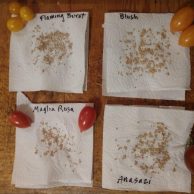 SAVING YOUR TOMATO SEEDS
SAVING YOUR TOMATO SEEDS
If you’re thinking about starting your own tomato plants from seed, you’ll be glad to know that it’s easy to save the seeds from heirlooms and other ‘open-pollinated’ tomatoes. One reason for this is that tomatoes are self-pollinating. This means that each flower is ‘perfect’, containing both male and female parts, and the arrangement of those parts is such that the female part (the stigma) is rarely exposed to the outside world before having been thoroughly ‘impregnated’ by the surrounding pollen-bearing anthers. Bees and other insects don’t really figure into the pollination of tomatoes. There are some older varieties derived from wild tomato that may be more vulnerable to cross-pollination, but don’t worry about that now. Do not bother to save seeds from hybrid varieties – only about 25% of them will resemble the plant from which you saved seeds.
WHAT YOU’LL NEED:
Clear cups, small jars or glasses
Small fine strainer
Paper towels
Adhesive tape
Permanent marking pen
Non-chlorinated water (filtered, spring, etc.)
- Choose the best, fully ripe tomato(es) from the most vigorous, disease-free, productive plants. Just to be on the safe side, choose fruits from the center of the plant where they are farthest away from other varieties. Do not save seeds from tomatoes you think might be disease-infected.
- Label a clear glass with a piece of tape with the variety name and the date.
- Cut a tomato horizontally across the middle. This exposes the seed cavities.
- Gently squeeze out the jelly-like substance that contains the seeds into the glass.
- Add an inch or two of non-chlorinated water and stir.
- Optional: Cover loosely with plastic wrap or waxed paper if you wish (if you are sensitive to mold spores, you may wish to include this step).
- Place on a warm (60–75 degrees F) shelf or counter where you won’t forget about it.
- Optional: stir once a day.
- Check after 3 or 4 days. A thin layer of whitish film (fungus) will have formed on the surface. It eats through the gelatinous coat surrounding each seed that inhibits germination. The fungus also produces antibodies that help control seed-borne diseases like bacterial spot and canker.
- Add warm water to the glass. Let the contents settle and begin carefully pouring off water along with pieces of pulp and any floating seeds (any seeds that float are immature and will not germinate). Repeat until the water being poured out is almost clear, with clean seeds resting at the bottom of the glass.
- Pour the seeds and water into a small, fine strainer (the spaces in the mesh must be smaller than your seeds).
- Tap the strainer to eliminate excess water, and invert the seeds onto a piece of folded paper towel. Try to spread the seeds into a single layer, but don’t fuss over it.
- Immediately label the paper towel with the name of the tomato variety.
- Allow the seeds to dry thoroughly- usually a day, sometimes more or less. Break up any clumps of seeds stuck to one another.
- Label a paper envelope with the variety name and the year, seal and store in a cool, dark, dry location. Some seed-savers like to keep seed envelopes in an air-tight container in the refrigerator.
- Tomato seeds should remain viable for at least 3 or 4 years when properly stored. Dryness is the most important factor.
Winter Watering Alert!

Winter Watering Alert!
The weather’s been wonderfully mild, but a bit DRY! All this sun and wind, with just a little rain or snow, is stressful to our plants, so don’t forget to give your plants some water.
This is especially true for new plantings, evergreens, and roses and most any plant that was planted in September or October. These plants are especially vulnerable and are more likely to suffer or die from dehydration than from cold.
Leave those Leaves Alone!

With this week’s unseasonably warm weather, there’s more time this fall to be out in the garden than usual.
DON’T BE TEMPTED TO CLEAN EVERTHING UP!
It’s important to leave many of those leaves and plants alone to support our insect, bird, animal and soils! It might be the most sustainable thing you can do this season.
Homemade Elderberry Syrup
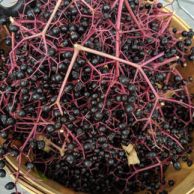
This fall, two of our Black Elderberry (Sambucus nigra) bushes performed especially well: ‘Mikl’s’ and ‘Marge’. Black Elder is considered the most beneficial species for herbal use.
We harvested a bounty, and are happy to share our favorite way to use them.
A healthy herbal remedy used for centuries, we love making Elderberry Syrup from berries harvested from the gorgeous elderberry shrubs and trees we can grow right here in Colorado!
This easy-to-make syrup recipe comes from Boulder wellness coach and herbalist Mitten Lowe.[Read More]
Mosquitos
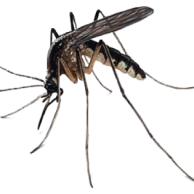
Are mosquitoes bugging you?
Mosquitoes are a problem this year. “Mosquito Man” Bob Hancock at Metro State University of Denver stated recently “We are not only breeding crazy numbers of mosquitoes here in Colorado with our rainy year, but we are keeping the ones that we’re breeding alive because it’s not getting as hot as it usually does.” Mosquitoes can be vectors for various diseases including West Nile Disease. Be proactive!
Fall Cold Weather Care and Protection
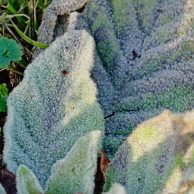
As Colorado gardeners, we’ve come to expect snow in October (last year it was October 10). It looks like this weekend might give us our first real freeze and chance for snow (the earliest recorded area snowfall was in 1961 when Denver received over 4″ of snow on Labor Day).
This translates into a lot of flower, fruit, and vegetable crops that are still productive that you might want to protect, harvest, and preserve. [Read More]
Patio Trees
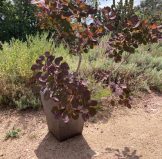
Purple Smokebush
MIKL’s ‘MACRO BONSAI’ PATIO TREES FOR YOURSELF!
Every so often, one of the trees or shrubs we’ve grown or received from a grower displays interesting twists, bends, curves or dwarfing that suggest the character of Bonsai specimens, but much bigger. Mikl has been collecting and cultivating these ‘Macro Bonsai’ for quite a few years. We have some available for sale right now.
Special Products you May Have Missed
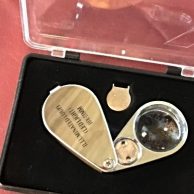
There is so much to look at when you visit Harlequin’s Gardens, it isn’t easy to take it all in!
Today we’re highlighting Special Products that may have escaped your notice, but which will greatly assist your gardening efforts.
Help Fall Plantings Beat the Heat
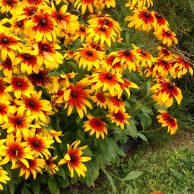 Fall is among the best times to plant perennials. While we may begin to wilt from late summer heat, many plants rise to the occasion and burst into bloom! As days begin to grow shorter, perennials spend the next few months developing root systems or taproots that delve well below the hot, dry surface soil. Pollinators depend on finding pollen and nectar sources through the entire summer, so it’s important to include late-summer and autumn bloomers in your garden.
Fall is among the best times to plant perennials. While we may begin to wilt from late summer heat, many plants rise to the occasion and burst into bloom! As days begin to grow shorter, perennials spend the next few months developing root systems or taproots that delve well below the hot, dry surface soil. Pollinators depend on finding pollen and nectar sources through the entire summer, so it’s important to include late-summer and autumn bloomers in your garden.
Here are a few suggestions for successful planting.
Some Good News on the Climate
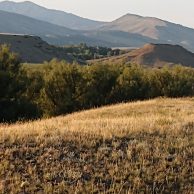
Bill McKibben, environmentalist, educator and founder of 350.org recently wrote, “If the last year has been about a phase change in our planet’s climate, the next year has to be about a phase change in our planet’s politics.”
This past week we did get significant good news about climate action, and we want to share it with you.
A Hint of Fall Specials
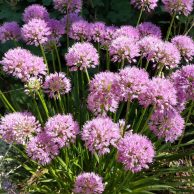
Summer is waning. Nights are cooler and we’re even closing some windows again. Lots of plants are producing seeds. The most comfortable planting season is here, and so are thousands of plants. And to sweeten the season even more, here come our Fall Sales! Next week you will receive our Fall Sale E-Newsletter, with complete information about our special Member’s Sale at the end of August, and our progressive Fall Sale for everyone! In the meantime, we have some pop-up sales appropriate to the season – see below for the details.
Season Extending Products
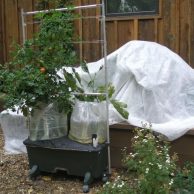
As Colorado gardeners, we’ve come to expect snow in October. But on September 9, 2020 we saw a temperature swing of more than 60 degrees, going from record-breaking heat to one of the earliest recorded snow falls in the state.
This translates into a lot of flower, fruit, and vegetable crops cut short, and a lot of unanticipated work protecting vulnerable plants, harvesting, and preserving. There are measures you can take now to be prepared to protect your gardens from cold weather and snow when they arrive, suddenly or not. The following tools, techniques, and ‘props’ can make the difference between life and untimely death of your plants during inclement weather.
Versatile Vines for Colorado Gardens
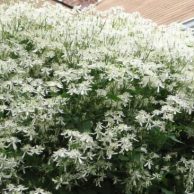
Sweet Autumn Clematis
Vines are very valuable for their versatility, variety and vigor, especially in the vertical plane. Sorry, I couldn’t resist. Many of us live in urban environments full of walls and fences, and closely packed homes with narrow side-yards. Those of us in townhomes, condos or apartments have only tiny patio gardens or balconies offering little opportunity for greening our outdoor spaces. Or, we live in new developments built on open farmland without mature trees and shrubs for shade or screening. In all of these situations, vines can quickly provide short-term or long-term solutions to provide privacy or shade, maximize our connection to the earth, block unpleasant views, cover ugly surfaces, or add a vertical dimension to the garden. And some vines can also work as groundcovers in tough situations, like under evergreen trees.
More About Vines
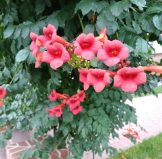
We’ve got a wonderful selection of vines right now! Last week we gave you an overview of vines and how to use them, based on their mechanisms for climbing. This week, let’s get into the details of some individual varieties.
Summer Garden Beet Salad Recipe
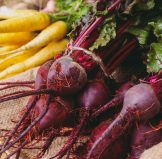 from Mitten Lowe at Journey to Wellness
from Mitten Lowe at Journey to Wellness
I love beets and beet greens for how grounding and nutritious they are – providing folate, dietary fiber, manganese, potassium, iron, antioxidants, phytonutrients, and more! This wonderful garden beet salad is a perfect way to utilize all parts of the beet plus it’s versatile and so incredibly satisfying.
Ready Now
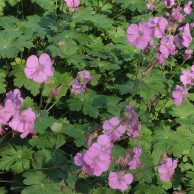
Geranium x cantabrigiense
Remember Spring of 2023? Cool, rainy and cloudy? We had many thousands of plants coming along from seed, cuttings and plugs. And under these challenging conditions, some of them took a very long time to reach the point when they became ready for sale. But they’re ready now! And some of our best groundcover plants for dry shade or part sun, Plumbago and hardy Geraniums (Cranesbills) are among them!
Here’s a list of some of the great plants, including many native plants (noted with an asterisk), we now have in stock.
Organic Weed Management: Now
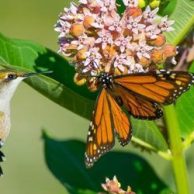
Non-toxic weed management, please!
by Mikl Brawner
The most effective time to remove weeds organically is NOW, when it’s HOT.
Harlequin’s Gardens is carrying two non-toxic* herbicides that WORK. There are non-toxic herbicides on the market that are a waste of money; we’ve tested them. The two we know that work are 20% Vinegar and Avenger Weed Killer.
Japanese Beetles are Back
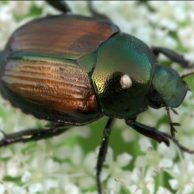 Japanese Beetle is one of the most damaging insect pests in the Eastern and Midwestern US, but
Japanese Beetle is one of the most damaging insect pests in the Eastern and Midwestern US, but
until fairly recently, Coloradans were spared that challenge. It entered the US in 1916, but took until 2003 before a population was established in Colorado.
GARDEN VEGGIES & HERBS – 2024 Newsletter
GARDEN VEGGIES & HERBS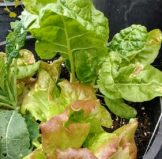
We’re bringing you a fantastic selection this year!
ARTICHOKE: Imperial Star
ARUGULA: Wild, Astro (spring), Ice Bred (fall)
ASIAN GREENS: Tat Soi, Joi Choi, Pak Choi, Red Giant and Miz America Mustards, Shiso and more!
BROCCOLI: Fiesta, Nutribud, Solstice, Broccoli Raab, Piracicaba
BRUSSEL SPROUTS: Speedia
CABBAGE: Golden Acre, Red Acre
CAULIFLOWER: De Purple, Snow Crown
CELERIAC: Brilliant
COLLARDS: Georgia Southern and 4 more!
CUCUMBERS: 10 varieties including Lemon, Marketmore 76, Armenian, Nat’l Pickling, Silver Slicer, and more!
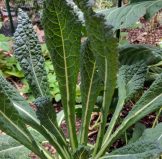
Lacinato Kale
KALE: Rainbow Dinosaur/Lacinato, Red Russian, White Russian Blue Curled Dwarf & 4 more!
LETTUCE: Several varieties of each type – Leaf, Butterhead, Romaine, Oakleaf, Batavian, Dwarf, Mixed, Mesclun
RHUBARB: Glaskins Perpetual, Victoria, Canada Red
SPINACH: Caucasian Climbing Perennial (Hablitzia tamnoides), Bloomsdale, Sun Angel, & more!
SWISS CHARD: Seafoam, Fordhook Giant, Perpetual Spinach, 5-Color Silverbeet, and more
MELON: Minnesota Midget, Tuscany, Noir des Carmes
PUMPKIN: Casper, Cherokee Bush, Cinderella, Jarrahdale, Winter Luxury
SUMMER SQUASH: Black Beauty, Yellow Zephyr, Dirani, Tromboncino, Jaune et Verte Scallop, Summer Crookneck +
WATERMELON: 6 varieties including Early Moonbeam, Sugar Baby, Blacktail Mountain, Moon and Stars
WINTER SQUASH: 15 includes Kabocha, Spaghetti, Uncle David’s Buttercup, Acorn, Honeyboat Delicata, Silver Bell +
PLUS: Amaranth, Bulbing Fennel, Collards, Endive, Escarole, Ground Cherry, Kohlrabi, Okra, Tomatillo, Radicchio, Watercress & more!
 HERBS, Culinary & Medicinal – Many varieties of THYME, LAVENDER, BASIL, MINT, ROSEMARY, SAGE, OREGANO, CHIVES, plus Parsley, French Tarragon, Cilantro, Dill, Fennel, Lemon Balm, Lemon Thyme, Lime Balm, Marjoram,, Lemon Grass, Vietnamese Coriander, Pineapple Sage, Lemon Verbena, Borage, Savory, Lovage, Cutting Celery, Catnip, Calendula, Aloe, Greek Mountain Tea, Comfrey, Echinacea , Feverfew, Lobelia, Valerian, Motherwort, Mullein, Sweet Leaf, Lomatium, Hyssop, Anise Hyssop, Plantain, Clary Sage, Skullcap, Arnica, Sheep Sorrel, Self-Heal, Rue, Mugwort, Wormwood, and more.
HERBS, Culinary & Medicinal – Many varieties of THYME, LAVENDER, BASIL, MINT, ROSEMARY, SAGE, OREGANO, CHIVES, plus Parsley, French Tarragon, Cilantro, Dill, Fennel, Lemon Balm, Lemon Thyme, Lime Balm, Marjoram,, Lemon Grass, Vietnamese Coriander, Pineapple Sage, Lemon Verbena, Borage, Savory, Lovage, Cutting Celery, Catnip, Calendula, Aloe, Greek Mountain Tea, Comfrey, Echinacea , Feverfew, Lobelia, Valerian, Motherwort, Mullein, Sweet Leaf, Lomatium, Hyssop, Anise Hyssop, Plantain, Clary Sage, Skullcap, Arnica, Sheep Sorrel, Self-Heal, Rue, Mugwort, Wormwood, and more.
The Inflation Reduction Act invests $20 billion to help the nation’s farmers respond to climate change…to plant perennial and cover crops and diversify crop rotations…that store carbon in the soil and build resilience against flood and drought.
Union of Concerned Scientists
Spring Gardening Begins!
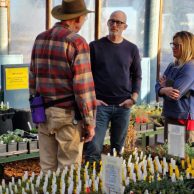
We are so happy to see you again, talk about our favorite subjects, share some hugs and some news, and to greet new customers too! Among our opening weekend’s first customers were a couple that drove up from Littleton for their first venture to Harlequin’s; their neighbor told them about our Fine Wood Chip mulch, that it knits together and stays in place, looks great, and feeds the soil, unlike the coarse wood chips and bark mulches you find elsewhere.
We had a lot to tell you about last week, soils and seeds, tools, classes and memberships, but didn’t tell you about the plants we have for sale! Yes! We’ve got native and beautifully adapted perennials and herbs that were over-wintered in an unheated but covered ‘house’. These can go home with you now, as long as you can let them ‘harden-off’ for about a week (introduce them gradually to the direct sun, wind and cold). See our instructions HERE. After hardening off, with only a few exceptions, these can be planted in March if you can work the soil.[Read More]
A Bit about Cucurbits
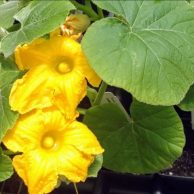 What’s a cucurbit? It’s any plant that’s in the Cucurbitaceae plant family. You eat them frequently and very likely grow them. This is the plant family that includes zucchini, summer and winter squash, pumpkin, cucumber, watermelon, cantaloupe and other sweet melons, and gourd.
What’s a cucurbit? It’s any plant that’s in the Cucurbitaceae plant family. You eat them frequently and very likely grow them. This is the plant family that includes zucchini, summer and winter squash, pumpkin, cucumber, watermelon, cantaloupe and other sweet melons, and gourd.
Time to Sow for Fall Harvests
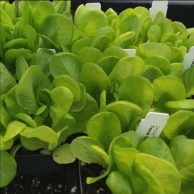
The next few weeks are the perfect time to sow arugula, beets, small carrots, lettuce, kale, radish, and more!
You’re looking to sow veggies that will be harvestable before our first big frosts – often in early October.
We’re proud to bring you seeds from Botanical Interests. They say, “Nurturing seeds in the garden slows us down to reconnect to nature and earth, develops bonds in a community, and creates family traditions and memories. We’re so happy to be a part of that!” And we are, too!
Mixed Herb Chimichurri Recipe
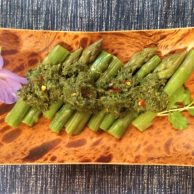
My favorite way to use fresh, home-grown Cilantro and my favorite way to get a concentrated hit of nutrition-packed greens is to make my own version of Chimichurri.
The Event of the Century is Here!
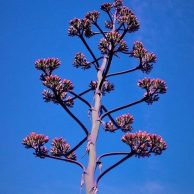
Well, it’s almost here …… we couldn’t wait any longer to tell you about it! Some of you may have guessed that we’re talking about the blooming of Eve and Mikl’s Agave parryi, aka Century Plant, which was planted 27 years ago. Last summer, Eve started whispering to it, suggesting that it might be time to think about blooming.
Ollin Farms Springtime Orzo Salad
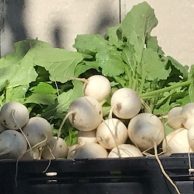
Late spring, with the blessing of all the rain we’ve had, offers some of the first harvests of the season. Asparagus, radish, and crisp, mild Hakurei turnips are showing up in CSA shares and at our farmers’ markets. Why not try this springtime salad recipe – the recipe and the vegetables are local, and delicious!
Dead or Alive?
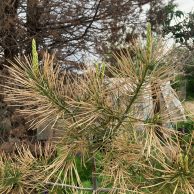
Lace Bark Pine
by Mikl Brawner
As we enter June, most of our trees and shrubs have leafed out, but not all. Some have leaves only three quarters of the way up, and many broad-leafed evergreens are mostly brown. Should we cut them back or replace them? Let’s not, just yet.
Wildflower Ramble
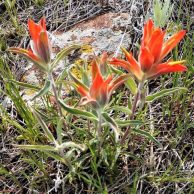
Castilleja integra
Yesterday’s Wildflower Ramble
Monday was a perfect day (except for the smoke) for us to take a wildflower ramble in our favorite foothills open space. I had one particular goal: to find Fringed Puccoon (Lithospermum incisum) in bloom. This is a very small plant with foliage and stature that are anything but charismatic, so searching for it when out of bloom is a lost cause. Even when blooming, the light lemon-yellow flowers are only a half inch across. It’s been many years since I have found any Fringed Puccoon in these meadows, and I was hoping that the generous rains we’ve had this month might have coaxed them out of hiding.[Read More]
Another Spring Wildflower Ramble
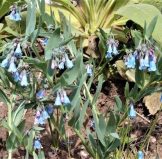
Mertensia lanceolata
In spite of cloudy skies and not-so-distant rumblings of thunder, Mikl and I had another opportunity to ramble among the wildflowers last week. This time, we chose the easy Lichen Loop trail at Heil Ranch, just off Lefhand Canyon Road. It’s amazing how long we can take to walk a mere 1.3 miles! Our excuse was the amazingly rich floristic display brought on by the combination of copious rain and wood ash from the Calwood Fire.
[Read More]
Lovely Lilacs: A Few Recipes
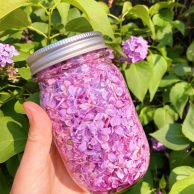
Lilac time is a very special and very short sweet time for us here in Colorado. Here are a few ways to use these flowers for health and well-being, from Mitten Lowe at Journey to Wellness.
We recommend harvesting lilac flowers while they are in full bloom, and making delicious medicine to enjoy through the rest of the year.
[Read More]
Fruit Trees for Your Yard
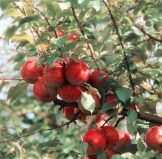 “The best time to plant a tree was 20 years ago. The second best time is NOW.” While this ancient Chinese proverb still rings true, fruit trees can begin to bear at a pretty young age, bringing satisfaction much sooner than a tree planted for shade or major presence in the landscape. We carry a wide selection of fruit trees proven to thrive and produce here in Colorado and taste great, and the apples, pears, cherries and plums on the list in the link below are in stock right now so that you can plant your own for years of enjoyment. (We don’t have peaches out at the moment – ask when you come in).
“The best time to plant a tree was 20 years ago. The second best time is NOW.” While this ancient Chinese proverb still rings true, fruit trees can begin to bear at a pretty young age, bringing satisfaction much sooner than a tree planted for shade or major presence in the landscape. We carry a wide selection of fruit trees proven to thrive and produce here in Colorado and taste great, and the apples, pears, cherries and plums on the list in the link below are in stock right now so that you can plant your own for years of enjoyment. (We don’t have peaches out at the moment – ask when you come in).
Special Woody Plants
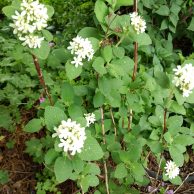
Jamesia americana – Waxflower
Mikl has assembled a collection of some of our most interesting, unusual and hard-to-find woody plants, many of which are just ready for sale now. These include some excellent native trees, shrubs and ground-covers, as well as particularly interesting and worthy non-natives that thrive in Colorado conditions. We’d like to share some descriptive profiles with you here.
Beautiful, Bountiful Biennials
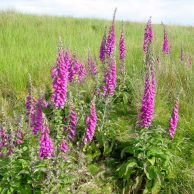
Digitalis purpurea – photo courtesy First Nature
Does everyone know what a biennial plant is? It’s a plant that spends its first year of life building a substantial root system and a basal rosette of foliage. In its second year, it will have the resources to support a season of massive blooming and seeding. After having done its job, it dies away, leaving the future of its kind to the new generation of seedlings it has created.[Read More]
The Spirit of Motherhood
 The nursery industry is well aware that the majority of shoppers for plants are women. And it’s not just a cliché that women are the leaders in nurturing. Most of us are here because mothers took care of us when we were helpless. It is the spirit of motherhood, in people of all genders, that is turning lawns into gardens and gardens into habitat. When we take plants from pots and put them in to soil, they are helpless until they grow their roots into the earth. Our care and nurturing mothers them until they are more independent. Then our relationship becomes a partnership, and the plants give back to us, too.[Read More]
The nursery industry is well aware that the majority of shoppers for plants are women. And it’s not just a cliché that women are the leaders in nurturing. Most of us are here because mothers took care of us when we were helpless. It is the spirit of motherhood, in people of all genders, that is turning lawns into gardens and gardens into habitat. When we take plants from pots and put them in to soil, they are helpless until they grow their roots into the earth. Our care and nurturing mothers them until they are more independent. Then our relationship becomes a partnership, and the plants give back to us, too.[Read More]
New This Week!
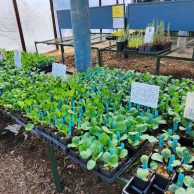
We are constantly bringing out new plants from our propagators and receiving deliveries of native, fruiting, perennial, woody and xeriscape specialty plants from our favorite local growers.
This week, we’re excited to bring you new tomato varieties, herbs and perennials.
Plant Select Turns 26

By Mikl Brawner
Not Just Another Pretty Face
We gardeners see a lot of branded plants in branded pots pushed with a lot of money to make a lot of money. That’s not the story with Colorado’s Plant Select program. Plant Select began as, and continues to be a plant promotion program genuinely aimed at the success of Rocky Mt. gardeners. It’s goals include saving water, supporting pollinators and encouraging a western garden aesthetic.
Legislature Forces HOA’s to Save Water on Landscaping
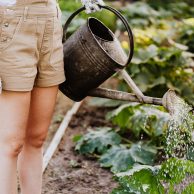
Around 60% of Coloradans live under a homeowner association. If you’re one of them, you know how difficult it is to get HOA approval for water-saving landscaping choices. Senate Bill 178 would allow homeowners to remove grass lawns, forcing HOAs to accept the alternative landscaping.
Benefits of the Beautiful Dandelion
![]()
Thinking this cheery yellow-flowered plant is a weed? Think again.
First of all, dandelions provide much needed early-season nutrition for the bees. If that wasn’t enough of a reason to let them into your garden, every part of this plant is good for you. Since ancient times dandelion has been used as a spring tonic. (That’s right, we’re suggesting eating the weeds!).
Blooming Without a Care
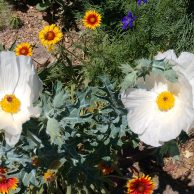
Argemone polyanthemos
by Mikl Brawner
DitchWeeds, Wildflowers, Native Forbs
Call them what you will: when Nature chooses, She knows what She’s doing. And She doesn’t need a human audience. Nature is happy playing to the bees, wasps, butterflies, moths and beetles. We humans can learn a thing or two just by noticing and appreciating Nature’s perfect performance. And that’s just what we gardeners do.
[Read More]
Own-Root Roses
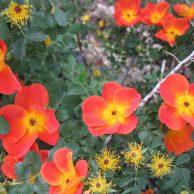 Did your roses take a hit from the winter cold and strong winds we just experienced? Perhaps they look as though they didn’t make it, showing brown, shriveled canes and no new growth above the ground. Or maybe there are no signs of life on the canes, but there is new growth just coming up from the ground. Either way, if your roses are growing on their own roots, you’re in luck. If they were grafted onto a rootstock, the prospects are not so good.[Read More]
Did your roses take a hit from the winter cold and strong winds we just experienced? Perhaps they look as though they didn’t make it, showing brown, shriveled canes and no new growth above the ground. Or maybe there are no signs of life on the canes, but there is new growth just coming up from the ground. Either way, if your roses are growing on their own roots, you’re in luck. If they were grafted onto a rootstock, the prospects are not so good.[Read More]



